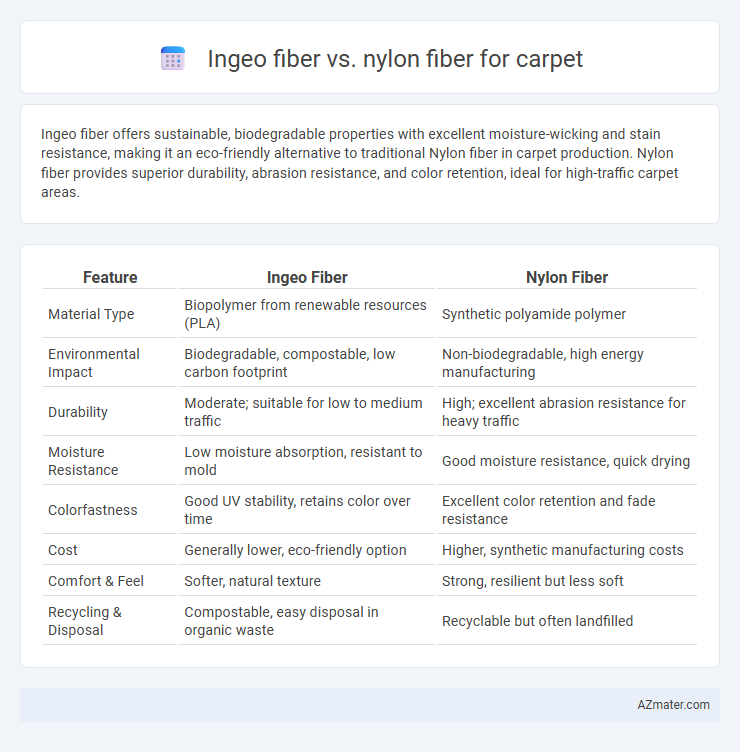Ingeo fiber offers sustainable, biodegradable properties with excellent moisture-wicking and stain resistance, making it an eco-friendly alternative to traditional Nylon fiber in carpet production. Nylon fiber provides superior durability, abrasion resistance, and color retention, ideal for high-traffic carpet areas.
Table of Comparison
| Feature | Ingeo Fiber | Nylon Fiber |
|---|---|---|
| Material Type | Biopolymer from renewable resources (PLA) | Synthetic polyamide polymer |
| Environmental Impact | Biodegradable, compostable, low carbon footprint | Non-biodegradable, high energy manufacturing |
| Durability | Moderate; suitable for low to medium traffic | High; excellent abrasion resistance for heavy traffic |
| Moisture Resistance | Low moisture absorption, resistant to mold | Good moisture resistance, quick drying |
| Colorfastness | Good UV stability, retains color over time | Excellent color retention and fade resistance |
| Cost | Generally lower, eco-friendly option | Higher, synthetic manufacturing costs |
| Comfort & Feel | Softer, natural texture | Strong, resilient but less soft |
| Recycling & Disposal | Compostable, easy disposal in organic waste | Recyclable but often landfilled |
Introduction to Ingeo Fiber and Nylon Fiber
Ingeo fiber, derived from renewable plant-based materials like corn, offers a sustainable and eco-friendly alternative to conventional synthetic fibers for carpet production. Nylon fiber, a petroleum-based synthetic polymer, is widely favored for its exceptional durability, abrasion resistance, and resilience in high-traffic carpet applications. Comparing Ingeo and nylon fibers highlights critical differences in biodegradability, carbon footprint, and performance characteristics relevant to carpet manufacturing and environmental impact.
Composition and Origin of Ingeo vs Nylon Fibers
Ingeo fiber is derived from renewable plant-based sources, primarily corn fermentation, making it a biopolymer composed of polylactic acid (PLA), whereas nylon fiber is a synthetic polymer produced from petroleum-based chemicals. The composition of Ingeo fibers offers biodegradability and lower environmental impact, contrasting with the petrochemical origin and higher durability of nylon. Ingeo's sustainable origin caters to eco-conscious carpet manufacturing, while nylon fibers provide superior strength and wear resistance.
Environmental Impact: Renewable vs Synthetic
Ingeo fiber, derived from renewable plant-based sources such as corn, offers a significantly lower environmental impact compared to synthetic nylon fiber, which is petroleum-based and non-renewable. Ingeo fibers are biodegradable and have a smaller carbon footprint due to their sustainable production process, whereas nylon production involves high energy consumption and generates toxic emissions. Choosing Ingeo fiber for carpets supports reduced landfill waste and promotes a circular economy through its compostable properties, contrasting with nylon's persistence in the environment.
Durability and Longevity Comparison
Ingeo fiber, derived from renewable plant-based sources, offers moderate durability but tends to have lower abrasion resistance compared to nylon fiber, which is known for its exceptional strength and resilience under heavy foot traffic. Nylon fiber carpets provide superior longevity, resisting wear, crushing, and staining more effectively than Ingeo fiber options, making them ideal for high-use areas. While Ingeo fiber is eco-friendly and biodegradable, nylon's robustness ensures longer-term performance and sustained aesthetic appeal in demanding environments.
Stain Resistance and Cleaning Ease
Ingeo fiber offers superior stain resistance compared to nylon fiber, thanks to its natural moisture-wicking properties, which prevent spills from penetrating the surface. Nylon fibers, while durable, tend to absorb stains more readily and require specialized cleaning agents to maintain appearance. Cleaning Ingeo fiber carpets often involves simple, eco-friendly methods that preserve fiber integrity and extend carpet life.
Comfort and Aesthetic Qualities
Ingeo fiber provides a soft, natural feel and excellent breathability, enhancing carpet comfort by maintaining a cooler surface underfoot compared to the more synthetic, less breathable nylon fiber. Ingeo's sustainable origin contributes to a matte, subtle sheen that adds a warm, organic aesthetic, while nylon fibers are known for their vibrant color retention and high durability, often resulting in a glossier finish. Carpet manufacturers often favor Ingeo for eco-friendly, comfortable options, whereas nylon fibers are preferred for high-traffic areas where resilience and stain resistance are critical.
Cost Analysis: Ingeo vs Nylon Carpets
Ingeo fiber carpets typically cost 20-30% more than nylon carpets due to the biobased production process and limited manufacturing scale. Nylon carpets benefit from established mass production, lowering raw material and processing expenses, resulting in competitive pricing for residential and commercial applications. While Ingeo offers sustainability advantages, nylon remains more cost-effective for budget-conscious carpet buyers.
Installation and Maintenance Differences
Ingeo fiber carpets offer easier installation due to their lightweight and flexibility compared to the denser nylon fiber, which requires more secure anchoring to prevent shifting. Maintenance of Ingeo fiber carpets involves lower chemical cleaning needs thanks to their natural resistance to staining and odor retention, whereas nylon fibers demand more frequent professional cleanings to maintain durability and appearance. The biodegradable nature of Ingeo fiber also reduces long-term environmental impact during disposal, contrasting with nylon's synthetic composition that complicates recycling processes.
Consumer Preferences and Market Trends
Ingeo fiber, derived from renewable plant-based sources, appeals to eco-conscious consumers seeking sustainable carpet options, whereas nylon fiber, known for its durability and stain resistance, remains popular for high-traffic areas. Market trends indicate a growing demand for biodegradable and low-VOC materials like Ingeo, driven by increasing environmental awareness and green building certifications. Consumer preferences are shifting towards blends that balance the performance of nylon with the ecological advantages of Ingeo fiber, reflecting a convergence of sustainability and functionality in carpet selections.
Conclusion: Choosing the Right Fiber for Carpets
Ingeo fiber offers eco-friendly benefits with its renewable plant-based origin, providing softness and sustainability, while nylon fiber delivers superior durability and stain resistance essential for high-traffic carpet areas. For environmentally conscious consumers prioritizing biodegradability and reduced carbon footprint, Ingeo is a suitable choice. In contrast, nylon remains the optimal fiber for carpets requiring maximum longevity and easy maintenance in commercial or heavily used residential spaces.

Infographic: Ingeo fiber vs Nylon fiber for Carpet
 azmater.com
azmater.com